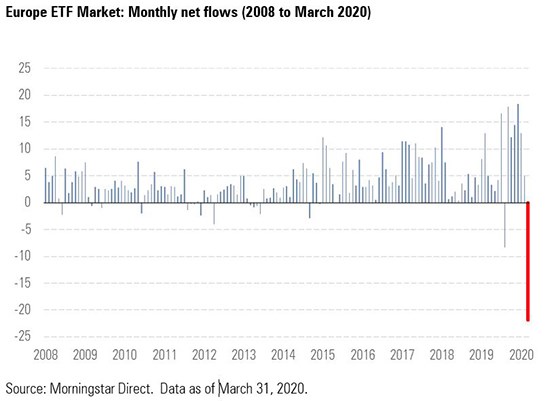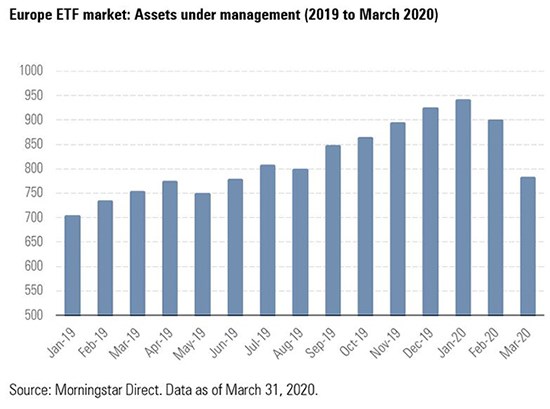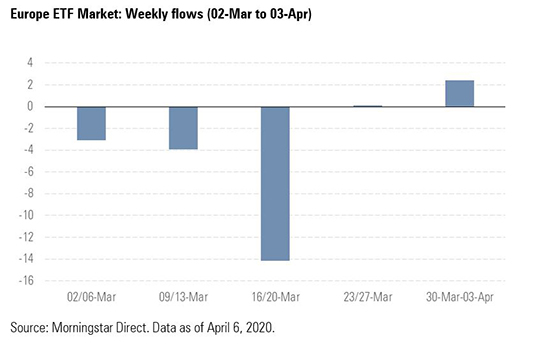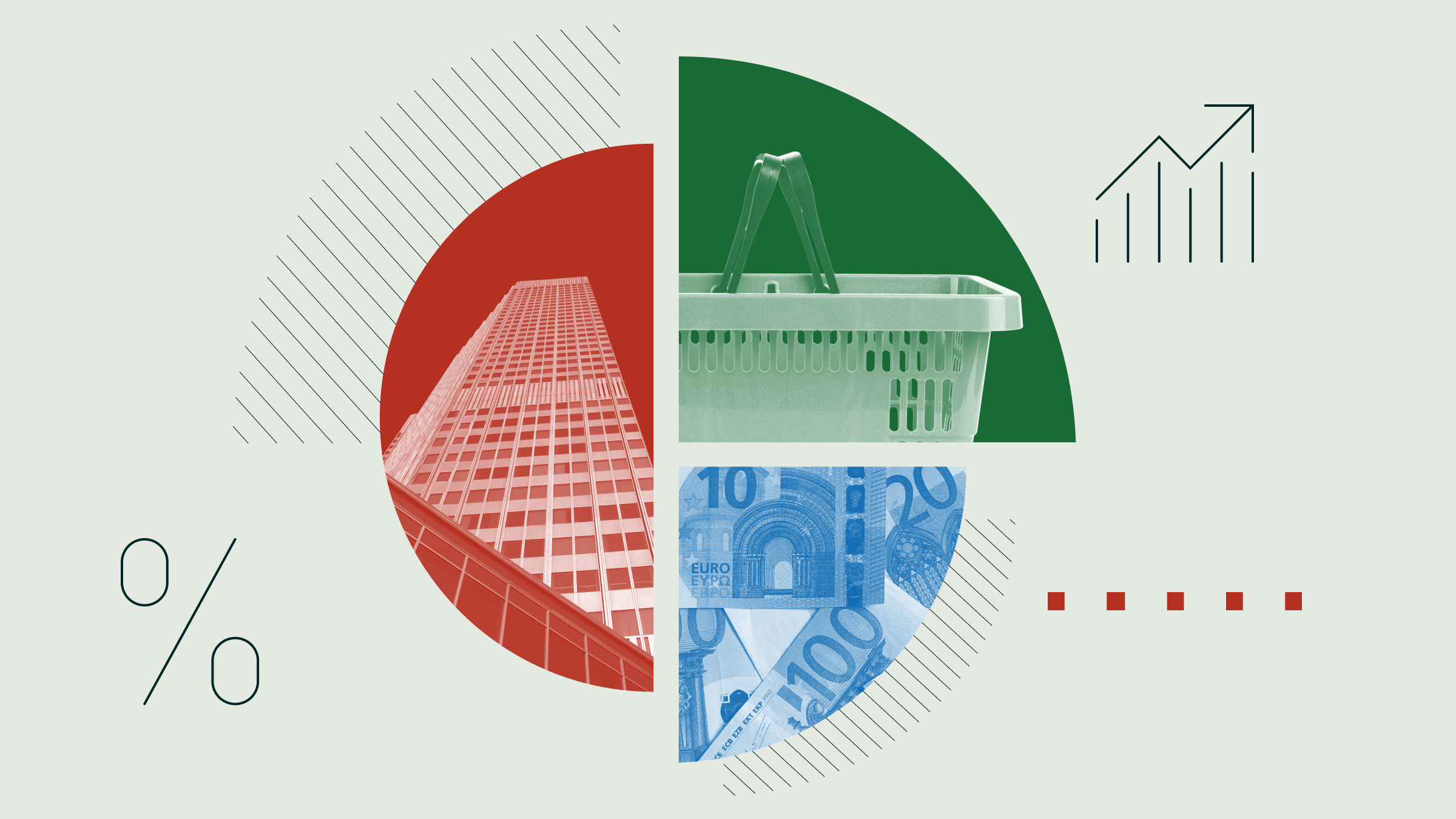
The European ETF market saw record outflows of €21.9 billion in March as investors reacted to the spread of coronavirus across the globe. This is a negative record high for an industry that has grown used to seeing an almost uninterrupted string of monthly net inflows since its establishment two decades ago.
We haven’t seen figures like these, even in the darkest days of the global financial crisis of 2008 or during the height of the eurozone debt crisis. Previously, the worst monthly net outflows recorded were €8.3 billion in August 2019, when weak economic indicators and a flare-up in the trade tensions between the US and China sent jitters through global equity markets. As the below chart shows, this was then followed by sharp rebound with net monthly inflows averaging €15 billion from September 2019 to January 2020.

Assets under management also saw a record-high fall of 13% from €899 billion in February to €781 billion in March - a drop of €117 billion, meaning that once accounting for the net outflows, investors have suffered just over €95 billion of capital losses over the month.
This is, perhaps, unsurprising given the sharp falls in equity and bond markets as entire economies came to a sudden standstill. Nevertheless, the scale of the figures is quite staggering. In one fell swoop, assets in European ETFs have dropped to the levels of June 2019; this is quite a change from the start of 2020 when many analysts were placing bets on when ETFs in Europe would hit the €1 trillion mark.

Signs of a Rebound?
The analysis of flows by week suggests that investors regained some poise in the closing stages of March and early days of April. This was clearly a reaction to the barrage of supportive policy measures announced both sides of the Atlantic, particularly Fed and ECB quantitative easing and the historic $2 trillion stimulus package approved by the Trump administration.
 It is, perhaps, too early to affirm that this heralds a solid turn in fortunes. After all, many investors are still trying to get their heads around how badly the lockdowns will impact the economy and, more importantly, how fast and in what shape (V or U) the recovery will be.
It is, perhaps, too early to affirm that this heralds a solid turn in fortunes. After all, many investors are still trying to get their heads around how badly the lockdowns will impact the economy and, more importantly, how fast and in what shape (V or U) the recovery will be.
However, so far in April, equity and bond markets have held up relatively well. Many investors may still prefer to play safe, but for many others the sharp cheapening in valuations is just too tempting to ignore.
A Look at Flows by Asset Class
Equity ETFs saw net outflows of €13 billion in March and assets fell to €467 billion from €559 billion in February and €604 billion in January. Assets in equity ETFs have dropped to the level of January 2019.
Analysis of Morningstar categories shows that US large cap equity ETFs suffered €5.4 billion of net outflows, followed by Emerging Market equity ETFs with €3.6 billion. Meanwhile, Europe large-cap equities closed the month with net inflows of €2.4 billion, German equity ETFs €1.2 billion, and UK large-cap equity ETFs €1.15 billion.

Fixed income ETFs also experienced €13 billion of net outflows in March. Assets in bond ETFs dropped to €219 billion from the record-high of €245 billion reached in February. In the case of fixed income, the monthly fall has brought assets in ETFs back to the level of September 2019.
In terms of categories, euro-denominated corporate bond ETFs saw the heaviest divesting, with net outflows of €2.7 billion in the month signalling investors’ uncertainty about future credit downgrades.
Emerging market debt ETFs – both local and hard currency – also experienced substantial outflows of €2.5 billion and €2.1 billion respectively. Other categories seeing net outflows include High Yield (both Euro and US) and US Treasuries. Meanwhile, eurozone government bond ETFs fulfilled their safe-haven role and saw net inflows of €1.8 billion, of which €0.8 billion directed at short maturity ETFs.

Unsurprisingly at times of heightened stress, commodities proved the ultimate shelter netting in close to €3 billion of flows over the month. This is a category where gold exchange-traded-commodities (ETC) have a large presence. Still, assets only grew very slightly to €78.3 billion from €77.8 billion in February, with the gains in gold products broadly offset by losses in oil-related investments. Coronavirus may have been the overriding investment story of the month, but the fracas between oil producers Russia and Saudi Arabia also hit markets.
Flows by Provider
UBS and iShares suffered the heaviest outflows in March at €7.2 billion and €6.6 billion respectively. In the case of UBS, the outflows were concentrated in equity ETFs, whereas for iShares the divesting focused in their fixed income ETF range. This is not surprising given the tight grip that iShares holds in bonds in the European ETF market.
Of the top 10 providers, Vanguard was the only one to close the month with significant net inflows at €1.9 billion. The Vanguard FTSE All-World High Dividend Yield ETF and the plain vanilla Vanguard FTSE All-World ETF attracted solid interest.



















